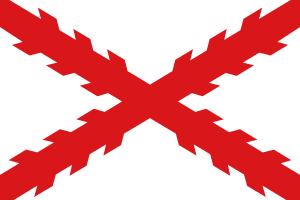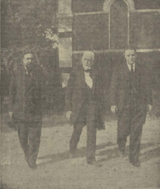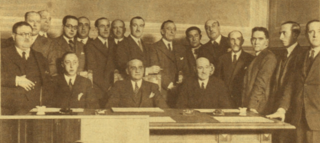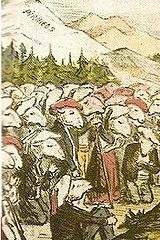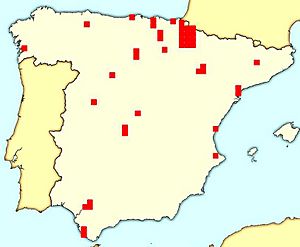Electoral Carlism (Second Republic) facts for kids
Carlism was a political group in Spain during the time of the Second Spanish Republic (1931-1939). While it wasn't as big as major parties like PSOE (Socialist Party) or CEDA (a large Catholic party), it was still an important group. In three elections for the Spanish parliament, called the Cortes, the Carlists won fewer than 50 seats, which was less than 3% of all available seats.
In the 1931 election, the Carlists were not very organized, but about 50,000 people voted for them. After they reorganized, their support grew. In the 1933 election, about 420,000 people voted for them (4.9% of voters). In 1936, this number was around 365,000 (3.8% of voters). Many more people, about 1.8 million, considered the Carlists an acceptable second choice. The Carlists were strongest in northern Spain, especially in Navarre, where they were a leading force. They also had some influence in the Basque Country, Old Castile, and Aragón. The most famous Carlist politician in the Cortes was Tomás Domínguez de Arévalo, who was elected in all three elections.
Contents
What Carlism Was About
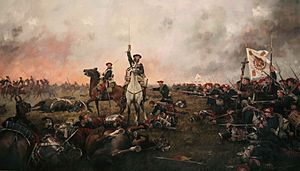
Carlism was historically known for fighting wars, not just for winning elections. They often used rifles more than ballot papers to try and gain political power. When they did run in elections, it was often to keep their supporters active and ready for another chance to take power by force. This was true during earlier periods in Spain's history, like the time of Queen Isabella II and the Restoration. During those times, Carlists usually had only a small number of seats in parliament.
In the early days of the Second Spanish Republic, many people thought Carlism was "already dead." They believed it was an old-fashioned movement from the past, like a relic. It started about a hundred years before, supporting old systems like feudalism, and many thought it was completely outdated by the late 1800s. Some even believed that a split in the movement in 1919 had finished it off. The poor results in the 1931 elections seemed to confirm this idea.
However, the Carlists showed a comeback in the following years, gaining over 2 million votes in later elections. Experts have different ideas why this happened. One idea is that the strong anti-religious views of the Republic pushed many voters towards extreme right-wing parties like Carlism. Another idea is that Carlism always did well during difficult times because it brought different groups together. For example, in the 1830s, it attracted people who wanted to keep the absolute monarchy. In the 1870s, it attracted conservative Catholics. In the 1930s, it attracted anyone worried about a revolution.
But Carlism also had its limits. Even though they defended Catholic values, larger, more modern Christian parties like CEDA were more popular. As supporters of a king, they struggled against the main monarchist group, the Alfonsists. And as advocates for regional self-rule, they couldn't compete with strong Basque and Catalan nationalist groups. All these factors, along with their election strategies, affected how well the Carlists did in elections.
How Carlists Did in Elections
| Carlist Election Results | |||||||||||
| year | % of voters | % of seats | |||||||||
|---|---|---|---|---|---|---|---|---|---|---|---|
| 1931 | 1.2% (4.8%) | 1.1% | |||||||||
| 1933 | 4.9% (17.7%) | 5.1% | |||||||||
| 1936 | 3.8% (18.3%) | 2.1% | |||||||||
Historians have slightly different numbers for how many Carlist candidates were elected between 1931 and 1936. Overall, they won between 32 and 50 seats in total across the three elections. This was far less than the most successful parties like CEDA, PSOE, and the Radicals, who each won around 200 seats. The Carlists were also behind medium-sized parties like Esquerra or other Republican groups, who won between 50 and 100 seats. The Carlists were in a group of medium-small parties that won 25-50 seats, similar to the Agrarians, Lliga, Renovación Española, or PNV. However, they did better than smaller Republican parties, the Communist Party, and other minor groups.
The differences in the numbers often come from how historians define who was a "Carlist." Sometimes, candidates linked to different types of Traditionalism are counted as Carlists. In 1931, three Traditionalist groups (the Integristas, Jaimistas, and Mellistas) were coming together but not yet officially united. The main Carlist organization, Comunión Tradicionalista (CT), which managed the 1933 and 1936 elections, officially formed in early 1932. Even after that, some candidates were unclear about their party loyalty. Also, in 1936, some Carlist election wins were later cancelled.
It's hard for historians to figure out the exact political identity of candidates and elected officials during this time. One expert, Javier Tusell, suggested counting only those who later joined the Carlist group in the Cortes or became part of the CT. But other historians use their own rules.
Carlist Goals and Friends
The main goals of the Carlists in all their election campaigns were to defend Catholicism, which they felt was threatened by the Republic's anti-religious laws, and to stop what they saw as a revolution led by left-wing parties. In 1931, they also strongly promoted the fueros, which were special traditional laws for certain regions. Later, this became less of a focus. The Republic was very careful about any mention of a king, so Carlist messages about the monarchy were often hidden. If they mentioned their leader, Don Jaime or Don Alfonso Carlos, they called him "our respected leader."
Other common themes in Carlist meetings included love for Spain, protecting traditional values like the family, and upholding law and order, including private property. They rarely talked about social issues, usually framing them as Christian charity or supporting farmers. Their traditional enemy, Liberalism, was gradually replaced by Marxism, including both Socialists and Communists. Sometimes, their speeches also included anti-Masonic and anti-Jewish ideas.
The Carlists' general goals seemed like they could easily join many right-wing groups. However, in reality, they were very strict when it came to forming alliances. They were suspicious of CEDA, a major Catholic party, because of its modern Catholic approach and its flexible political views. Another monarchist group, Renovación Española, was even less trusted because it strongly supported the Alfonsist royal family. Parties that wanted regional self-rule, like the Basque PNV or the Catalan La Lliga, made the Carlists nervous because they worried about separatism and loyalty to Spain.
Perhaps the most likely ally for the Carlists was the Partido Agrario, a conservative group of landowners and farmers. Candidates from both parties often appeared on the same election lists. Some even claimed to represent both parties, and the Carlists officially supported some Agrarian candidates.
The Carlist party itself was divided on alliances. They were most open to deals when Rodezno was their leader (mid-1932 to mid-1934). As a result, the Carlists never signed a full national agreement with another party. Twice they came close. Before the 1931 election, they formed a "Catholic-Fuerista" list with PNV, but this was only in the Basque Country and Navarre. Before the 1933 election, they joined Renovación Española in TYRE, a group for coordinating monarchist elections. This effort was not fully supported and barely continued in 1936.
So, in 1933 and 1936, any alliances the Carlists made were at the provincial level. Except in Navarre, the Carlists were always the smaller partner in these alliances. If talks failed, a Carlist candidate would run alone, usually without success. Their dislike of making deals, especially in 1936, affected their election results. In 1933 and 1936, all Carlist candidates combined received about 2.1 million votes in each election. In 1933, they won 24 seats, but in 1936, they only won 10 seats.
Who Voted for Carlists
The election system during the Republic encouraged groups to form coalitions, and voters often voted for all candidates on a single list. This makes it hard for historians to know the exact number of people who supported a specific party. A simple way to estimate Carlist support is to add up all votes for candidates identified as Carlists. In 1931, this was about 270,000 votes. In 1933, it was close to 2.11 million, and in 1936, it was 2.21 million votes.
However, these numbers don't tell us how many voters chose Carlism as their first choice. Since voters could pick several candidates, these figures mostly show that in the mid-1930s, about 1.8 million Spaniards (18% of active voters) were willing to support a Carlist candidate, either as their top choice or as an acceptable partner.
Historians use special methods to estimate how many people truly preferred Carlism. One method suggests that about 51,000 people in 1931, 422,000 in 1933, and 366,000 in 1936 chose Carlism as their first option. This means Carlism was the first choice for about 1.2% of active voters in 1931, 4.9% in 1933, and 3.8% in 1936. These are likely the lowest estimates, as some Carlist voters might have lived in areas without a Carlist candidate.
No studies have fully described the typical Carlist voter, like their gender, age, education, job, or where they lived. However, studies of specific areas and analyses of Carlism during the Spanish Civil War suggest that Carlism was a diverse movement that attracted people from different social classes. Some experts even say it was "the most inter-class right-wing movement in Spain."
Carlism was especially popular in rural areas, like small towns and villages, rather than in big cities. Only three Carlist politicians were elected from large city areas. Many historians also note that Carlism wasn't equally strong in all rural areas. It was more popular among small and medium-sized farmers than among farm workers who didn't own land.
Where Carlism Was Strong
Carlism was not strong all over Spain. Its ability to compete in all election areas was quite low, ranging from 20% in 1931 to 48% in 1933. Most of the seats Carlists won (about two-thirds) were in the northern part of the country. However, this was more balanced than in earlier times, when they won almost no seats south of the Sierra de Guadarrama mountains. In the 1930s, they saw a small comeback in New Castile and Andalusia.
In the past, three regions—Catalonia, Navarre, and the Basque Country—provided 81% of all Carlist seats. But between 1931 and 1936, these three regions accounted for only 46% of Carlist seats. Navarre clearly remained the Carlist heartland, providing 26% of all their seats. However, the party became less dependent on Navarre compared to earlier times. The Carlist center of strength moved away from the Basque Country and Catalonia. The Basque Country provided only 13% of seats (down from 30%), and Catalonia provided 8% (down from 16%).
| Regions with Most Carlist Seats (% of seats won) | |||||||||||
| no | district | 1931 | 1933 | 1936 | total | ||||||
|---|---|---|---|---|---|---|---|---|---|---|---|
| 1 | Navarre | 28.6% | 57.1% | 57.1% | 47.6% | ||||||
| 2 | Vascongadas | 11.8% | 11.8% | 5.9% | 9.8% | ||||||
| 3 | Aragon | 0.0% | 9.5% | 4.8% | 4.8% | ||||||
| 4 | Old Castile | 0.0% | 9.8% | 2.4% | 4.1% | ||||||
| 5 | Asturias | 0.0% | 6.3% | 0.0% | 2.1% | ||||||
| 6 | Catalonia | 0.0% | 3.8% | 1.9% | 1.9% | ||||||
| 7 | Andalusia | 0.0% | 4.5% | 1.1% | 1.9% | ||||||
| 8 | Valencia | 0.0% | 5.4% | 0.0% | 1.8% | ||||||
| 9 | New Castile | 1.6% | 1.6% | 1.6% | 1.6% | ||||||
| 10 | Leon | 0.0% | 4.5% | 0.0% | 1.5% | ||||||
| 11 | Galicia | 0.0% | 2.1% | 0.0% | 0.7% | ||||||
| 12 | Baleares | 0.0% | 0.0% | 0.0% | 0.0% | ||||||
| 12 | Canarias | 0.0% | 0.0% | 0.0% | 0.0% | ||||||
| 12 | Extremadura | 0.0% | 0.0% | 0.0% | 0.0% | ||||||
| 12 | Murcia | 0.0% | 0.0% | 0.0% | 0.0% | ||||||
| SPAIN | 1.1% | 5.1% | 2.1% | 2.8% | |||||||
Navarre remained the strongest Carlist region, where they won 48% of all available seats between 1931 and 1936. In three other regions—the Basque Country (10%), Old Castile (5%), and Aragón (5%)—Carlism was a noticeable but not dominant force. In six other regions, the party had only a small presence, winning between 1.5% and 2% of seats. These included Andalusia, Asturias, Catalonia, León, New Castile, and Valencia.
Compared to earlier periods, Carlist success generally decreased across most of the country, especially in former strongholds like the Basque Country and Catalonia. However, there were exceptions. In Navarre, the Carlist share of seats actually increased from 36% in the Restoration period. They also saw relative growth in Old Castile and regions where they had won no seats before 1923.
Because the Republic changed the electoral system from small, single-seat districts to larger, multi-seat districts, it's hard to compare exact geographic support. At the provincial level, the areas with the highest Carlist success were Navarre (48%), Álava (33%), Tarragona (10%), and Zaragoza (9%). A big change happened in Gipuzkoa, where Carlists used to win 33% of seats but only 6% between 1931 and 1936. Other provinces that traditionally supported Carlism, especially on the Mediterranean coast like Girona and Barcelona in Catalonia, became less supportive.
Key Carlist Figures
Sixty-five different people ran as Carlist candidates for the Republican Cortes, and 30 of them won. One person, Tomás Domínguez de Arévalo (also known as conde de Rodezno), was elected in all three elections. Five other Carlist politicians served two terms: Luis Arellano Dihinx, Joaquín Bau Nolla, Jesús Comín Sagüés, Gínez Martínez Rubio, and José Luis Oriol Uriguen. However, none of the Carlist members of parliament became as famous as other right-wing leaders like José Calvo Sotelo or José María Gil-Robles.
While some Carlist politicians were known for their intelligence, some, like Víctor Pradera, didn't try to get elected to the Cortes. Others, like Luis Hernando de Larramendi, ran but lost. Larramendi is notable because he was the only Carlist candidate who ran in all three elections (1931, 1933, and 1936) and lost every time.
It's hard to create a full profile of all Carlist candidates due to limited information. We know that there were 64 men and one woman among them. Most of the elected Carlists were lawyers, landowners, and business owners. Many were in their 30s, 40s, or 50s, with a few younger or older individuals. Five of the Carlist members of parliament had served in the Cortes before 1923. The most experienced was Esteban Bilbao, who had served three terms before 1923. His record was not as long as Manuel Senante, who served eight terms as an Integrist (a Traditionalist group) before 1923, but Senante lost his two attempts to be elected during the Republic.
Bilbao later became very important in Francoist Spain, serving as Minister of Justice and president of the Cortes for a long time. On the other hand, six Carlist members of parliament later lost their lives due to political conflict.
It might seem strange that out of the 10 candidates who received the most votes, 7 did not win. This happened because they ran in large cities, where Carlism was usually not very popular. For example, Roman Oyarzun received 186,000 votes in Madrid in 1936 but still lost. The Carlist candidate who performed best in terms of the percentage of votes was Miguel de Miranda y Mateo, who in Logroño in 1933 was supported by 87% of active voters. The worst result was for Francisco Martínez García, who only got 1,469 votes in Murcia in 1936.
The main political leader of the Carlists, called the jefe delegado, changed over time. In 1931, marqués de Villores ran in Valencia and lost. In 1933, conde de Rodezno won easily in Navarre. In 1936, Fal Conde, who had tried and failed as an Integrist in 1931, chose not to run. During the 1931-1933 term, there wasn't a formal Carlist group in parliament, but they were part of a Catholic-Fuerista group led by Joaquin Beunza. From 1933 onwards, Conde de Rodezno formally led the Carlist parliamentary group.
See also
 In Spanish: Carlismo electoral (Segunda República) para niños
In Spanish: Carlismo electoral (Segunda República) para niños
- Carlism
- Traditionalism (Spain)
- Electoral Carlism (Restoration)
- Carlo-francoism


